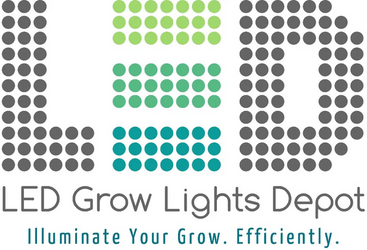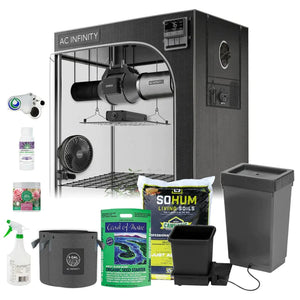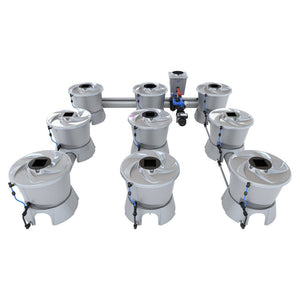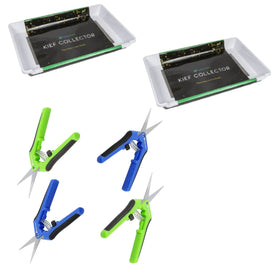
New to LED Grow Lights? Start here. How to choose the BEST LED grow light for your grow.
If you are new to the world of LED grow lights or have been researching LEDs to determine which one or several are the best for you and your grow, then you have come upon the right place.
This article will guide through the sea of LED grow lights, by showing you EXACTLY what you should consider before choosing an LED grow light. After reading this you will be able to make an informed purchase decision while cutting through the LED grow light marketing fluff.

In this LED grow light purchasing guide you will learn about the following important considerations:
- Coverage area
- Spectrum
- Wattage
- Light output
- Par efficiency
- Budget
- Reviews/Recommendations
- Secondary lenses, advanced features, warranty
Coverage area
The driving factor in determining the best LED grow light depends on the area you need to cover. Customer’s always ask what light they need or which one we recommend, but without more information it is difficult to direct them. Therefore, knowing their ‘coverage area’ helps guide the rest of the LED grow light decision process.
It might be safe to assume that most home growers setup a grow in a 4’x4’ area. But some people grow in a 2’x’2, 3’x3’, 5’x5’, or a rectangular area. Some home and commercial grows are quite large and require several fixtures. Knowing the exact space you want to grow in helps narrow down how small or large of a light fixture you need. Too much light is wasted money, but not enough light can lead to less than desirable growth and yields.
One of the specifications on an LED grow light is the ‘recommended coverage area’. We highly suggest that this is the first thing you consider when choosing a fixture. The ‘recommended coverage area’ specification should primarily be used for smaller grows that only need one or a few fixtures. But larger commercial grows that require several fixtures could require fewer fixtures due to the effect of light contribution from nearby fixtures. Commercial applications should always consult and obtain professional advice and often a light plan before installing lighting. A light plan shows how many fixtures are needed to obtain the light level targets in a given coverage area.

Img: Optilux 16 lightplan
Spectrum
Veg or Bloom
Many LED fixtures are full spectrum/full-cycle which means that they will carry a seedling all the way through harvest with a single, dual, or alterable spectrum. When you use these types of lights, you don't need to switch out the light fixture like you did in the old days (MH to HPS). For many growers this is good news since they can keep the lights and the plants in the same place for the entire grow.
Yet, for growers who want to have separate veg and flower rooms, they might consider a spectrum designed the specific phase of growth. Veg fixtures primarily have a strong blue spectrum (4000K to 5000K, for example), while flower spectrums are heavy in red (2700K, for example). Though this is not always true since one spectrum can veg and flower an entire grow. Overall, you will need to know what you are buying to ensure it is recommended for either full-cycle growth or for a specific phase of growth.
The next step in deciding on an LED grow light revolves around the specific wavelengths included in the fixture. Do you want a full-spectrum white light, a full spectrum white light with additional wavelengths, or a pinkish/purple light (comprised of mostly red and blue diodes)?
White light
There has been a trend in the LED grow light world with many manufacturers incorporating full spectrum white light into their fixtures via chip-on-board LEDs or single diodes. The advantages of these are that they provide a full spectrum and the intensity needed for optimal growth and flowering.
Furthermore, there is a lot of green light in a white light spectrum. Why is green light important? Green light is absorbed deep in the leaves where red and blue light are not absorbed, as well as penetrate leaves to drive photosynthesis deeper into the canopy (see the end of this article for two references on green light and plant growth). Some LED grow lights on the market, like the NextLight Mega and Horticultural Lighting Group HLG 550 only use full spectrum white light diodes heavy in green.

Img: Horticultural Lighting Group HLG 550
White light + additional wavelengths
There are some other brands, like Amare, that use full spectrum COBs to provide the intensity and the needed wavelengths for good growth, however, they will 'round out' the spectrum with individual diodes such as UV-A, blue, deep red, and far red. Manufacturers who add additional wavelengths, do so to fill in the 'missing colors', accentuate a particular wavelength, increase photosynthetic efficiency, and/or boost intensity. Adding these additional wavelengths help bring the spectrum curve closer to the McCree action spectrum for higher plants. This spectrum curve is a measure of photosynthetic efficiency at each wavelength. Therefore, closely replicating it by adding additional wavelengths can be beneficial to the plants.

Img: McCree's action spectrum
It is still early in the LED game to say whether a plain white light spectrum or a rounded out spectrum will perform better. Both spectrums perform well, but one might conclude that a more targeted spectrum is more efficient. One spectrum might be better for a certain type of strain or for a particular light intensity. What we do know for sure is wavelength ratios are important, but light intensity is likely the most important factor for driving growth and yields.
Img: Amare SE 500 + UVB
Red and Blue focused
There are other brands on the market that mostly focus on red and blue with little added green, and maybe some UV and far red in the spectrum, too. This curve is based on the chlorophyll absorption graphs which show the absorption peaks for chlorophyll in the blue and red regions.

Img: Chlorophyll absorption peaks
Manufacturers who have designed spectrums around this curve are overlooking an important observation: Chloroplasts are located on the upper layer of cells on the leaf and therefore the reds and blues get absorbed first. Without any or much green light, there is not any light energy to bounce around in the leaves and get absorbed or penetrate the leaves to drive photosynthesis under the canopy.
...Notice how incorporating a full spectrum white light, which includes heavy greens, is beneficial in growing high-light plants, especially in dense canopy situations?
As long as the light intensity is strong enough in red and blue dominant spectrums, this spectrum will perform fairly well since the light can still reach deep into the canopy. More over, if the spectrum is not tuned enough, the lack of green light can lead to deficiencies. Carotenoids require some light blue and green light to fully activate their synthesis.

Img: Mars Hydro Pro II Epistar 320
Ultraviolet and Far Red
You might consider a fixture with UV and far red wavelengths. UV-A is absorbed by plants, and affects development, growth, and metabolism. While it is not necessary for good growth and flower development, many growers gravitate toward LED fixtures with UV-A.
What about UV-B? There is good evidence that UV-B increases trichome production, along with THC, CBDs, and terpene content. There appears to be enough data from grower’s experiences along with what occurs in nature to back this idea up (plants have higher THC content in elevations and latitudes with higher UV indexes). LED grow light companies do not include UV-B diodes in their fixtures because the diodes are expensive and can have a short lifespan. To get around this issue, companies add UV-B via a fluorescent bulb integrated into the fixture (Amare SE 450) or as a supplemental component (California Lightworks).
Far red light has also shown to be a beneficial wavelength as it works by increasing photosynthetic rates via the Emerson Effect. Most LED grow lights on the market include IR light. However, it is not necessary for normal growth and development.
Wattage
Many growers are used to using grow light wattage to determine how much power they need per square foot of grow space. It is not recommended that you use wattage to determine a fixture's footprint or potential. BUT, if you DO use wattage to determine this, keep in mind that you need a minimum of 32 watts per square foot. The most efficient LED grow lights on the market require 32 watts per square foot, but less efficient fixtures (more lower light intensity with a higher power draw), will require that you either use the fixture to cover a smaller area or you add supplemental lighting to increase the intensity.
Quick Chart
Assume a minimum of 32 watts/sq ft for flowering
- 1' x 1': 32 watts
- 2' x 2': 128 watts
- 3' x 3': 288 watts
- 4' x 4': 512 watts
- 5' x 5': 800 watts
- 6' x 6': 1152 watts
Also note, you should never use wattage to determine how much useable light an LED grow light emits. Wattage can vary dramatically between fixtures and brands: There are LED grow lights that will cover a 4.5'x4.5’ area that only draw 515 watts, and fixtures that cover a 4’x4’ area that draw 760 watts. Ideally, you want the fewest amount of watts with the largest footprint. The only problem is that a manufacturer can say the light covers a 4’x4’, but if the consumer does not know the Photosynthetic Photon Flux Density (PPFD), also known as light intensity as far as a plant is concerned, this statement is useless.
Another issue with using wattage to determine a fixtures footprint is that all of the wattage drawn does not get converted to light. Some power is lost to the driver, cooling fans (if present), and the rest of the energy is lost as heat.
In sum, it is best to not use wattage to determine a grow light’s intensity, ability to grow your plants, or coverage area. So what should you use? Use PPF and PPFD.
Light output
PPF
How much light does the unit emit? This is stated in the specifications as the PPF, or Photosynthetic Photon Flux, reported in umol/s. The fixture’s light output should be referenced to ensure the unit will actually perform well in the specified grow area. For reference, a double-ended Gavita will emit 2000 umol/s. This is a lot of light and one of the reasons why they perform very well. However, they are placed several feet above the plants so not all of this light reaches the plants at extremely high intensity. LED grow lights that replace a DE HPS may only have a PPF of 1400 umol/s. But these lights are sometimes placed 10”-12” from the plants so the light that reaches your plants is alot higher than what would reach them with a DE HPS hung several feet above them.
PPFD
PPF is important, but PPFD is what you need to consider. The ideal manufacturer will take Photosynthetic Active Radiation (PAR) measurements and map these out over a 4’x 4’ area (or however large area the light claims to cover). They will also tell you the average PPFD. Why is this important? Because a fixture may emit a lot of light in the center of the footprint, but the sides of the 4’x4’ area may have 10x less light reaching them. Light intensity is important, but the uniformity of the footprint is just as important. Therefore, the average PPFD reading will provide you with the average light intensity over the 4’x4’ area and allow you to compare these measurements with other manufacturers.
Larger yields can be obtained by increasing light intensity, but only up to 1500 umol/m2/s without extra CO2 supplementation. Some manufacturers recommend staying below 1000 umol/m2/s because above this light level you do not see a reasonable return on investment (yields) considering the excess light and energy draw. The issue is that when a manufacturer says that their light will cover a 4’x’4 area, for example, do you know at what intensities? Is that at an average of 500 umol/m2/s, 900 umol/m2/s, or more? This is another reason why it is important to consider the average PPFD reading for the recommended coverage area.
PAR Efficiency
PAR efficiency is how many micromoles of light are emitted per joule of energy consumed. In other words, it is a measure of how much light is being emitted per watt of electricity drawn at the wall. This is important because LEDs should be efficient, yet some fixtures use inferior diodes and drivers that are not efficient, and therefore consume more electricity than is ideal. Efficient LED fixtures will save you money on electricity while delivering a lot of light to your plants.
If you can afford a higher quality fixture, it will likely be more efficient than some of the other LEDs on the market. Choose a grow light that has an efficiency above 1.5 umol/j. Most of them do. If it is not stated, then contact the manufacturer to see if they can provide this information. Anything above 2.0 umol/j is considered very efficient. At this time 2.4 umol/j is the highest efficiency that can be attained in an LED grow light. As diode efficiency increases over the next several years, expect fixtures to reach 3.0 umol/j.
Budget
Your budget is perhaps the most important factor in determining what LED grow light you purchase. With less money expect a smaller or inferior light. There are many inexpensive lights on the market that will work well for growing, but how efficient are they, is the spectrum ideal, are they intense enough for your grow footprint, is the footprint fairly even, will they break down in a year? These are questions you need to consider before making an investment.
With more money, you will be able to purchase a larger fixture or higher quality fixture. Just be careful because there are a lot of LED grow lights that are expensive that might not meet your needs. Do your research based on the criteria in this guide.
There is a lot of overlap in LED grow light pricing and it can be confusing. Why do lights that cover a 4’x’4 area range from $700 to $2000? Again, it depends on what you are willing to pay for. Do you want top bin, high-efficiency diodes, a high average PAR, uniformity, and a good warranty? Then you are going to pay more for it. If all you have is $700 and are willing to sacrifice some of these things, then the $700 light is right for you. If your budget is larger and you want the highest quality light source, then the $2000 light is your best option. Rule of thumb: Buy the best LED grow light that you can afford.
Another option is to consider DIY LED kits if you don't mind assembling your own light fixture.
Reviews/Recommendations
Some growers read the forums to see who is using what light and what their experience has been. This is a good way to see how the light performs in real life instead of just reading and listening to marketing material.
YouTube is another good source for checking out LED grows or watching unboxings and reviews.
If you are set on a particular light, why that one? Make sure that the light is not all smoke and mirrors. How many reviews have you seen on it? What data are you using to backup your own claim and what is the source of that data?
Secondary considerations
You might also consider the following when purchasing an LED grow light:
Secondary lenses
Adding secondary optics increased light intensity by concentrating the outgoing light into a smaller area. This is ideal for getting the most out of a smaller grow space, but may not be idea for creating an even light canopy for larger grows. Consult the PAR map of the fixture for light unifomity.
Advanced features
Do you want dimmability, spectrum control, timing, scheduling control? These are not necessary, but instead is for those growers who want complete lighting automation built-in to the fixture as well as the ability to experiment with spectrums. It is a nice benefit, but fixtures with this ability are generally a bit more expensive.
Warranty
Does the manufacturer have good customer service and can they stand behind their warranty and claims? A longer warranty will likely increase the price of the fixture. 5-year warranties are ideal. Some brands have 7-year warranties, but this is rare. 3-year warranties tend to be the norm for most lights.
Summary
Coverage area
What size space are you growing in? This will determine the size, light intensity, and light spread of the LED grow light.
Spectrum
Are you vegging, blooming, or both? Do you want a full spectrum LED grow light or a grow light that is heavy in reds or blues?
Wattage
Larger fixtures draw more power and generally exude more light in a larger area. Smaller fixtures draw less power and emit less light in a smaller area. Don't use wattage to determine how large of a footprint an LED grow light will cover. Use PPF, average PPFD, and consider the evenness of the footprint by consulting the PAR map.
Light output
What is the PPF and average PPFD of the fixture. Is this sufficient for the space you are growing in? How is the light spread over this area? Is it mostly even or very low on the edges? How will this affect your grow?
PAR efficiency
How much light does the fixture produce per watt consumed at the wall? Is it above 1.5 umol/j? Is it very efficient and above 2.0 umol/j? Did the manufacturer even provide this information in the specs? Can you request it or calculate it yourself with the specs that are provided (PPF/wall watts = PAR efficiency)?
Budget
How much do you want to spend on an LED grow light? High-quality fixtures are more expensive, but higher quality. Expensive fixtures may also have a lot of bells and whistles that you don't need. Consider your wants vs your needs. Less expensive fixtures are generally, but not always, lower quality and you might be sacrificing efficiency, light output, quality, or warranty length when you buy a less expensive fixture.
Reviews/Recommendations
What do you know about this light and from who do you know it from? Have you heard good things/bad things about the brand or the specific light fixture? Have you watched reviews of the light or seen the light in action?
Secondary lenses, advanced features, warranty
Secondary lenses may not be ideal for larger grows where a lot of light overlap is required. Do you want/need a fixture with spectrum, dimming, timing, and scheduling control? Are you willing to pay for these extra features? What benefit will they have for you and your grow? Is the warranty length sufficient? Have you read the details?
Next Steps
If you need to filter down your LED grow light requirements, you can do so in the navigation bar at the top of the website by searching by brand, coverage area, type, wattage draw, or HID replacement wattage.
If you still need direction or assistance choosing an LED grow light, feel free to reach out to us at sales@ledgrowlightsdepot.com. We have helped hundreds of customers choose a light. Happy grows!
Resources
Green Light Drives Leaf Photosynthesis More Efficiently than Red Light in Strong White Light: http://bit.ly/2tnydNc
Possible reasons of a decline in growth of Chinese cabbage under a combined narrowband red and blue light in comparison with illumination by high-pressure sodium lamp: http://bit.ly/2sqtT2c








Comments
Leave a comment